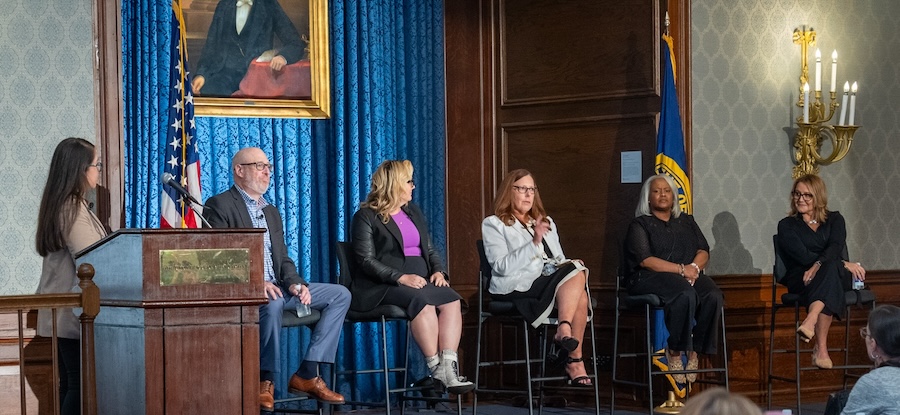People First: The Crucial Role of Investing in Employees


Chelsie Rae Lee, CEO and co-founder of Knowwn, says over her 14 years working for Southern California Edison, she held 17 different roles. By moving within the company she was able to figure out what she was good at through different opportunities, all of which later helped her found her own company. During a session at From Day One’s Philadelphia conference, Rae Lee and other executive panelists shared their ideas on how companies can ensure they are investing in their employees to create a thriving workplace.
Kate Feather, SVP, head of HR, corporate functions for Lincoln Financial Group, said it’s powerful when managers “show up as fans of their teams and their individual employees.” She favors the idea of employers acting almost as fans of their workers and providing them with unconditional support. Support can take place in the form of engagement like one-on-one meetings and encouraging development through projects, meetings, or building connections with people.
At NFI Industries, a supply chain management company, they have implemented cohort-based learning programs for potential leaders. Melissa Winkelman, the SVP of HR, is a graduate from one of these cohort programs—one specifically for women in leadership. By encouraging women in the company to attend this program Winkelman says that retention rates for women in the company is 81%, and 71% who attended have been promoted.
Just like in any form of relationship, creating personal connections between individuals allows for a development for a stronger foundation. “There’s a big difference between giving someone a $20 gift card to Amazon and giving someone a $5 gift card to the coffee shop that you know they go to every day with their coworker,” said Rae Lee. Rae Lee emphasizes that making the effort to make sure your employees know they are personally cared for can make a bigger impact on employee investment.
Investing in Employees
When employees don’t feel seen or heard, they might leave you mentally or physically, says Dana Valentine, vice president of HR at Comcast. Employees might start to become disengaged, less productive or leave the company without valuable company investment efforts.
Lincoln Financial Group offers their employees opportunities for career growth and development through an opportunities marketplace where anyone can post a project or a job shadowing opportunity. “By building skills-based mentoring into this program, not only are we giving the employees the opportunity to be mentored on specific skills that are important for their employability, but we’re also giving the managers who want to cultivate talent the opportunity to do that too,” said Feather.

Rae Lee says “the formal ability for people to move around within the company and really understand themselves is so critical to people’s growth personally.”
“You are the architect of your own career,” said Feather, who encourages employers to have consistent conversations with employees about what they want to get out of their career. She also encourages employees to talk to their managers about their interests in new paths and how to go down their desired career paths.
Measuring Success
While companies are creating new programs to support employee growth, not all initiatives will be successful. Implementing new efforts can be a process of trial and error but what pitfalls should managers look out for when introducing new programs?
Russ Freyman, VP of business development for Progyny, a family building and reproductive health organization, says it's important to evaluate the metrics of what defines success. “You can declare success just because it feels good, but if you don’t have a metric at the end of the day that you were moving towards, maybe it wasn’t successful,” said Freyman.
When it involves the company budget, Valentine says that managers need to carry a wider lens of how much of an impact their initiatives will make and the tradeoffs to afford them.
Success of these programs are measured in different ways. In order to understand whether an initiative has a positive impact, companies must identify the problem, their intentions and what they are trying to measure. Rather than implement programs broadly for happier employees. It’s important to look into employee engagement, retention rates, and impact of recognition, says Feather.
“Oftentimes, we’re trying to measure tenure, retention, those kinds of things. One of the things that I've seen done well is really deciding for each position, what does success look like?” said Rae Lee.
Employee surveys are one way to gauge employee sentiments within a company. Freyman highlights that it’s a useful tool to measure the sentiments of up and coming leaders, underrepresented groups and employee resource groups to ensure “you have a happy workforce and a healthy workforce.”
For initiatives to have a strong impact, the entire organization also needs to be on board with the company goals. “You need organizational buy-in and support from all across your business,” said Winkleman.
Jennifer Yoshikoshi is a local news and education reporter based in the San Francisco Bay Area.
The From Day One Newsletter is a monthly roundup of articles, features, and editorials on innovative ways for companies to forge stronger relationships with their employees, customers, and communities.